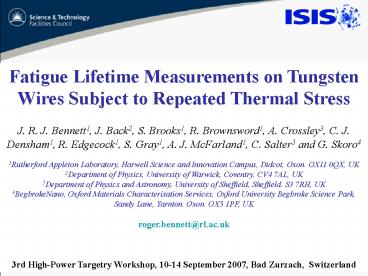Fatigue Lifetime Measurements on Tungsten Wires Subject to Repeated Thermal Stress - PowerPoint PPT Presentation
1 / 32
Title:
Fatigue Lifetime Measurements on Tungsten Wires Subject to Repeated Thermal Stress
Description:
Fatigue Lifetime Measurements on Tungsten Wires Subject to Repeated Thermal Stress – PowerPoint PPT presentation
Number of Views:48
Avg rating:3.0/5.0
Title: Fatigue Lifetime Measurements on Tungsten Wires Subject to Repeated Thermal Stress
1
Fatigue Lifetime Measurements on Tungsten Wires
Subject to Repeated Thermal Stress J. R. J.
Bennett1, J. Back2, S. Brooks1, R. Brownsword1,
A. Crossley3, C. J. Densham1, R. Edgecock1, S.
Gray1, A. J. McFarland1, C. Salter3 and G.
Skoro4 1Rutherford Appleton Laboratory, Harwell
Science and Innovation Campus, Didcot, Oxon. OX11
0QX, UK 2Department of Physics, University of
Warwick, Coventry. CV4 7AL, UK 3Department of
Physics and Astronomy, University of Sheffield,
Sheffield. S3 7RH, UK 4BegbrokeNano, Oxford
Materials Characterisation Services, Oxford
University Begbroke Science Park, Sandy Lane,
Yarnton. Oxon. OX5 1PF, UK roger.bennett_at_rl.ac.uk
3rd High-Power Targetry Workshop, 10-14
September 2007, Bad Zurzach, Switzerland
2
- OUTLINE
- Introduction
- Wire tests
- SEM measurements
- Conclusions
- Future work
3
The primary purpose of these tests is to address
the problem of thermal shock at high temperatures.
To find a refractory material that will withstand
the thermal stresses/fatigue and have a long life
of 1-10 years. 1 year corresponds to 106
pulses on an individual target bar.
4
- It is not possible to test the full size targets
in a proton beam and do a life test. - The solution
- Produce shocks by passing high current pulses
through thin wires.
5
Lorenz Force
Thermal Force
Lorenz Thermal Force
100 ns pulse
Typical radial stress in the wire from thermal
and Lorentz forces
Goran Skoro
6
3 micro-pulses in 2 cm diameter target
micro-pulse
macro-pulse
3 micro-pulses in 3 cm diameter target
5 micro-pulses in 3 cm diameter target
Goran Skoro
Macro-pulse length, ms
7
(No Transcript)
8
Test wire, 0.5 mm F
Pulsed Power Supply. 0-60 kV 0-10000 A 100 ns
rise and fall time 800 ns flat top Repetition
rate 50 Hz or sub-multiples of 2
Coaxial wires
Vacuum chamber, 2x10-7 -1x10-6 mbar
Schematic circuit diagram of the wire test
equipment
9
(No Transcript)
10
Vertical Section through the Wire Test Apparatus
11
W26 Tungsten Wire Assembly
12
Picture of the pulse current, 200 ns/division
13
Picture of the pulse current, 1 ?s/division
14
Picture of the wire test equipment
15
Measurement of the Pulse Temperature 1 kHz
measurement rate
16
Tests on Tantalum Wire The wire lasted for a few
hundred thousand pulses before breaking or
bending. Tantalum is not a suitable material
since it too weak at high temperatures (1600-2000
K).
17
Photograph of the tantalum wire showing
characteristic wiggles before failure.
18
Ultimate
Ultimate
Yield
Yield
Ultimate
Yield
Yield and Ultimate Strength of Tantalum and
alloys versus Temperature.
19
Yield Strength of Tungsten and some Alloys versus
Temperature
20
Ultimate Tensile Strength, MPa
Ultimate Tensile Strength of Tungsten and some
Alloys versus Temperature
21
Tests on Tungsten Wire Tungsten is much stronger
than Tantalum particularly at high
temperatures. So - try Tungsten
22
Some Results 0.5 mm diameter Tungsten Wires
Equivalent Target This shows the equivalent
beam power (MW) and target radius (cm) in a real
target for the same stress in the test wire.
Assumes a parabolic beam distribution and 3
micro-pulses per macro-pulse of 20 micro-s.
23
- Radiation Damage
- Experience on the ISIS targets show that there is
no serious problem up to 12 dpa. - Tungsten pellets irradiated (15-20 dpa) at PSI
will be examined when cool enough. - Tests at BNL, (Nick Simos).
24
- SEM ANALYSIS OF 4 SAMPLES OF TUNGSTEN WIRE.
- Chris Salter
- With the aim to observe any surface or internal
damage which might indicate the presence of
thermal fatigue. Micro-cracks can indicate
fatigue. - Samples. 4 wires were supplied, W31 to W34.
- The following techniques were used to
characterise the samples - SEM imaging of the wires as delivered using both
the secondary electron and the back-scattered
electron signal. - With some energy dispersive analysis to
determine the nature of some of the features
observed. - The same samples were mounted in cold setting
resin and polished, again observed using the SEM.
25
Results and Discussion Wire W31 Unbroken wire
An extensive search found no surface signs of
any fatigue cracks. However, the surface of the
tungsten wire had been thermally etched in the
central region, with extensive removal of
material from the grain boundary regions. Also,
No signs of cracks in the sections. Wire W32 and
33 Broken. No signs of fatigue micro-cracks.
But wire severely melted at brake. Wire W34
Crack just appeared in thermal test, Broke on
cooling. Massive cracking near the brake in the
wire. Is this a sign of fatigue stress?
26
W34
27
W34. Showing cracking at surface behind the main
fracture surface, still in necking zone.
28
W 34. Section
29
W34. Section
30
W34. Section
31
Conclusions I believe that the viability of solid
tungsten targets at high-temperature for a long
life (10 years) has been demonstrated with
respect to thermal shock and fatigue and will not
suffer undue radiation damage.
32
- Future Programme
- Continue wire tests with Tungsten and Graphite.
- Continue modelling computations.
- Continue SEM measurements.
- VISAR measurements to asses the properties of
tungsten, and any changes, during the wire tests.
(Effect of thermal shock.) - Tests with a proton beam to confirm wire tests
and VISAR measurements but limited number of
pulses. - Radiation damage studies.
- Test alloys of tungsten.
- Design build a model of the target bar system.
- Design the solenoid.
- Design and cost the complete target station
including the beam dump.































